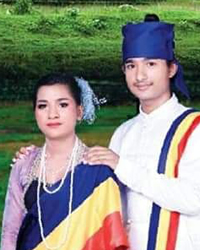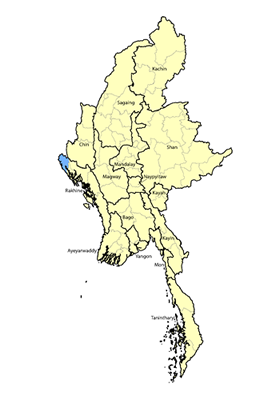For such a small group, the Barua people have played an oversized role in the history of their region, which sits at the juncture of Myanmar, Bangladesh, and India. Although other ethnicities often refer to them as the “Maramagyi,” the name Barua is derived from two words meaning “renowned ruler. According to one source, in ancient times the highest-ranked military ruler of Chattogram in Bangladesh was a man named Barua. In India the Barua are a group without official classification, being considered neither a tribe nor a caste.
Location: Numbering only about 500 people in Myanmar, the Barua inhabit Buthidaung and Maungdaw townships in the northern tip of Myanmar's Rakhine State. The two townships are 16 miles (26 km) apart on either side of the Mayu Mountains but are connected by two tunnels that were built in 1918. Maungdaw is just 6 miles (10 km) from the Bangladesh border across the Naf River. The border is the gateway to Chittagong, where hundreds of thousands of refugees have fled to avoid the violence of the Burmese military in recent decades. Most Barua people (33,000) live in Bangladesh, with an additional 1,500 found in northeast India's small Tripura State, which is bordered by Bangladesh on three sides.
Language: Without a language of their own, Barua people have adopted the dominant vernaculars of the areas they inhabit. In Myanmar they speak the Rakhine language, while on the Bangladesh side of the border they speak Chittagonian, which is a variety of Bengali.
The Barua say their forefathers were originally traders who came to Rakhine in today's Myanmar from India in the fifth century. They settled in the Mrauk-U area, although it didn't flourish into a trading center and kingdom for another thousand years. In the past few decades, the Barua have found themselves entangled in the civil strife that has infested Rakhine State, although because they are Buddhists, they have not been subjected to the same kind of genocidal treatment inflicted upon the Muslim Rohingya people. The current civil war in Myanmar has paralyzed the area. In May 2024 the Arakan Army seized control of Buthidaung in another blow to the government in the multi-faceted civil war.
After Barua women marry, “they wear vermilion and conch-shell bangles as marriage symbols and as a sign of their unavailability to men. Residence after marriage is patrilocal. Although either spouse can seek divorce, its incidence is rare. Nowadays, the practice of paying bride-price in cash is being replaced by that of dowry.” Traditionally, the Barua earned their livelihood through farming, fishing, and hunting, but the number of wild animals has greatly diminished, making hunting a fruitless exercise. Today the Barua raise goats and chickens as their main sources of protein, while some men and women in the towns have obtained jobs as office workers, teachers, and administrators.
Although for centuries they have been surrounded by Muslims and Hindus in Bangladesh and India, the Barua have stubbornly retained their faith in Buddhism. Barua families are “linked with a Buddhist temple and brought under their traditional association. They worship at the family level and participate in traditional festivals.” Maungdaw District, where the Barua live, is 91 percent Muslim. Just how the Barua first became Buddhists is difficult to ascertain because they have no written history. In India, the Barua are now allowed to marry people from Hindu communities, but only from high-caste groups, as the Barua want to preserve their heritage as upper-class rulers.
Because Buddhism is so entrenched as a major part of their ethnic and cultural identity, there are no known Barua Christians in any of the three countries where they dwell. In Myanmar the Rakhine the Jesus film is available but is rarely shown. Surrounded by hundreds of thousands of Muslims and Buddhists, little Gospel witness has occurred in this isolated part of the country, making the Barua one of the most unreached and unevangelized people groups in Myanmar.
Scripture Prayers for the Barua in Myanmar (Burma).
| Profile Source: Asia Harvest Copyrighted © Used with permission |











